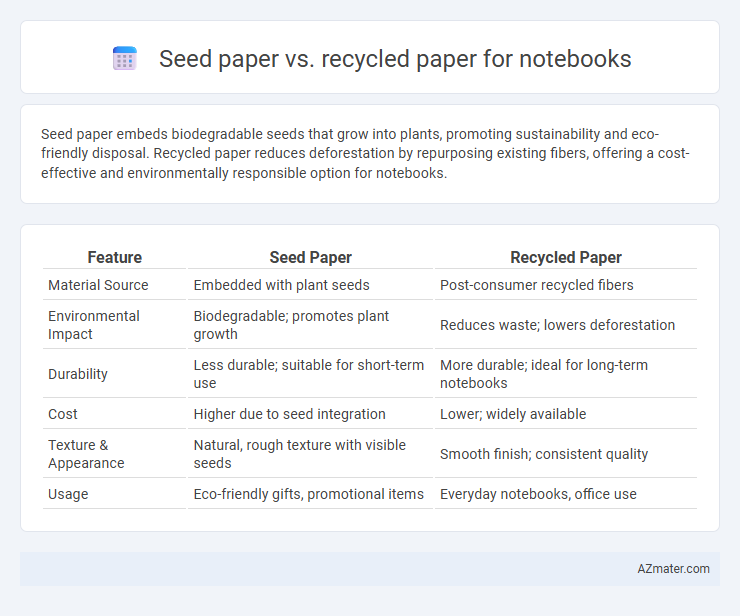Seed paper embeds biodegradable seeds that grow into plants, promoting sustainability and eco-friendly disposal. Recycled paper reduces deforestation by repurposing existing fibers, offering a cost-effective and environmentally responsible option for notebooks.
Table of Comparison
| Feature | Seed Paper | Recycled Paper |
|---|---|---|
| Material Source | Embedded with plant seeds | Post-consumer recycled fibers |
| Environmental Impact | Biodegradable; promotes plant growth | Reduces waste; lowers deforestation |
| Durability | Less durable; suitable for short-term use | More durable; ideal for long-term notebooks |
| Cost | Higher due to seed integration | Lower; widely available |
| Texture & Appearance | Natural, rough texture with visible seeds | Smooth finish; consistent quality |
| Usage | Eco-friendly gifts, promotional items | Everyday notebooks, office use |
Introduction to Sustainable Paper Options
Seed paper integrates embedded seeds that enable direct planting after use, promoting environmental regeneration by reducing waste and supporting biodiversity. Recycled paper for notebooks utilizes post-consumer or post-industrial fibers, significantly lowering deforestation and energy consumption compared to virgin paper production. Both options represent sustainable paper choices aimed at minimizing ecological footprints in stationery products.
What is Seed Paper?
Seed paper is a type of eco-friendly paper embedded with seeds that can be planted to grow flowers, herbs, or vegetables after use, making it a sustainable choice for notebooks. It combines recycled paper fibers with biodegradable seed pods, promoting environmental conservation and reducing waste. Unlike traditional recycled paper, seed paper offers a unique interactive element that supports biodiversity and encourages users to engage in gardening.
What is Recycled Paper?
Recycled paper is made from post-consumer or post-industrial waste materials that are reprocessed to reduce environmental impact and conserve natural resources. This paper undergoes a pulping process where old paper products are broken down and reformed into new sheets, often containing a mix of fibers to maintain durability and print quality. Compared to seed paper, recycled paper emphasizes resource efficiency and waste reduction rather than embedding seeds for planting.
Environmental Impact Comparison
Seed paper notebooks promote environmental sustainability by being fully biodegradable and capable of growing plants when planted, reducing waste and encouraging biodiversity. Recycled paper notebooks lower deforestation rates and conserve natural resources by repurposing existing paper fibers, but their production still involves energy and water consumption. Choosing seed paper over recycled paper enhances eco-friendly practices by combining waste reduction with active ecological regeneration.
Production Processes: Seed vs Recycled Paper
Seed paper production integrates biodegradable paper pulp embedded with seeds, requiring minimal chemical processing to preserve seed viability, whereas recycled paper production involves collecting, sorting, and deinking used paper to create new pulp. The seed paper process emphasizes eco-friendly ingredients and gentle drying methods to maintain seed germination potential, contrasting with recycled paper's multi-step pulping and bleaching treatments aimed at removing inks and contaminants. Seed paper's production targets sustainability through natural growth potential, while recycled paper focuses on waste reduction and resource efficiency in manufacturing.
Quality and Durability Factors
Seed paper offers unique biodegradability with embedded seeds but tends to be more fragile, affecting long-term durability and resistance to wear. Recycled paper provides enhanced strength and consistent quality due to controlled manufacturing processes, making it more suitable for daily use in notebooks. The choice between seed paper and recycled paper hinges on balancing eco-friendliness against the need for durable, high-quality pages.
Applications in Notebook Manufacturing
Seed paper enhances sustainability in notebook manufacturing by integrating embedded seeds that facilitate plant growth after use, appealing to eco-conscious consumers. Recycled paper supports resource efficiency by reducing deforestation and minimizing waste through repurposed fibers, making it ideal for budget-friendly and mass-produced notebooks. Both materials contribute to environmental goals, with seed paper offering unique post-use applications and recycled paper providing a low-impact raw material source.
Cost Considerations for Consumers and Producers
Seed paper typically incurs higher production costs due to embedded organic seeds and specialized manufacturing processes, affecting consumer prices which are generally above those of recycled paper notebooks. Recycled paper offers a cost-effective alternative, leveraging established recycling streams and less complex production methods, resulting in lower retail prices and broader market accessibility. Producers must balance seed paper's premium appeal and environmental benefits against its higher expenses, while recycled paper provides scalable, budget-friendly options with consistent demand.
User Experience and Aesthetics
Seed paper notebooks offer a unique tactile experience with textured, slightly rough surfaces that engage users and promote eco-consciousness by allowing pages to be planted after use. Recycled paper notebooks provide a smoother, more uniform texture that enhances writing comfort and durability while showcasing environmentally responsible production through visible recycled fibers. Both options balance sustainability with distinct aesthetic qualities, appealing to users seeking either natural, organic looks or clean, refined finishes in their stationery.
Which Paper is Right for Your Notebook?
Seed paper integrates embedded seeds that sprout when planted, ideal for eco-conscious users seeking sustainability and a life cycle beyond traditional use. Recycled paper, made from reclaimed fibers, offers cost-effective durability and reduces environmental impact by minimizing waste and resource consumption. Choosing between seed paper and recycled paper depends on prioritizing either innovative biodegradability or reliable, eco-friendly materials for notebook production.

Infographic: Seed paper vs Recycled paper for Notebook
 azmater.com
azmater.com